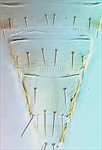Generic diagnosis
Female macropterous. Head slightly prolonged with broad interantennal projection; maxillary palps 3-segmented; eyes without pigmented facets; ocellar setae I present; setae III small. Antennae 7-segmented, segment I without paired dorso-apical setae, III and IV with sense cones forked. Pronotum with no long setae, with five pairs of small posteromarginal setae. Mesonotum with median and submedian pairs of setae usually arranged transversely; campaniform sensilla absent. Metanotal median setae behind anterior margin; campaniform sensilla absent. Fore wing first vein with long gap in setal row; second vein with three setae widely spaced; posteromarginal fringe cilia wavy. Prosternal ferna divided; basantra membranous without setae. Mesosternum with sternopleural sutures reaching anterior margin; endofurca with or without spinula. Metasternal endofurca with spinula. Tarsi 2-segmented. Tergites not clearly divided from laterotergites, without posteromarginal craspeda or ctenidia; tergites II–VIII laterally and laterotergites with numerous ciliate microtrichia on sculpture lines, tergite S1 setae much longer than distance between their bases; VIII with posteromarginal comb complete; IX without campaniform sensilla; X without median split. Sternites without discal setae or craspeda, with ciliate microtrichia on sculpture lines at least laterally, posteromarginal microtrichia present; sternites III–VII with three pairs of posteromarginal setae, II with two pairs, sternite VII with S1 setae at posterior margin.
Male similar to female, tergite IX without drepanae; sternites without pore plates.
Biological data
The members of this genus seem to be associated particularly with the leaves of Ficus species [Moraceae].
Distribution data
All four species in this genus are known only from southeast Asia, between India, southern Japan and northern Australia. In contrast, arorai has also been found in Florida (Mound & Wang, 2000), apparently introduced through the horticultural trade in Ficus species.
Nomenclatural data
Anascirtothrips Bhatti, 1961: 26. Type species Anascirtothrips arorai Bhatti, 1961, by monotypy.
Only four species are reccognised in this genus (ThripsWiki, 2020), with two recorded from China:
arorai Bhatti, 1961: 26.
discordiae Chen & Lu, 1994: 90.
Relationship data
Thripidae sub-family Thripinae: this is a diverse group involving more than 230 genera. Species of this genus are similar in structure to the species of Scirtothrips, but have only seven antennal segments (Masumoto & Okajima, 2007).
References
Masumoto M & Okajima S (2007) The genus Scirtothrips Shull (Insecta, Thysanoptera, Thripidae) and three related genera in Japan. Zootaxa, 1552: 1–33.
Mound LA & Wang CL (2000) The genus Anascirtothrips (Thysanoptera: Thripidae), from leaves of Ficus trees in India, Taiwan and Australia. Chinese Journal of Entomology 20: 327–333.
ThripsWiki (2020) ThripsWiki - providing information on the World's thrips. <http://thrips.info/wiki/Main_Page>



